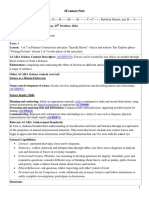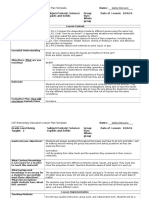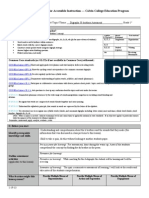Friction 2
Friction 2
Uploaded by
api-240278294Copyright:
Available Formats
Friction 2
Friction 2
Uploaded by
api-240278294Original Title
Copyright
Available Formats
Share this document
Did you find this document useful?
Is this content inappropriate?
Copyright:
Available Formats
Friction 2
Friction 2
Uploaded by
api-240278294Copyright:
Available Formats
Lesson Planning Form for Differentiating Instruction Calvin College
Education Program
Teacher
Date n/a
Kelley Tuinenga
Subject/ Topic/ Theme:
Friction: How much force does it take?
I. Objectives
What is the main focus of this lesson?
The main focus of this lesson is to introduce the unit and identify friction as a force that changes the way
an object moves. In this activity the students will be testing various surfaces and the amount of force it
takes to get a block of wood to move.
How does this lesson tie in to a unit plan?
The unit is on friction and its affect on moving and resting objects.
What are your objectives for this lesson?
1) Students will investigate the affects of friction and force on an object.
2) Identify friction as a force that changes the way an object moves.
3) W.3.2- Write informative/explanatory texts to examine a topic and convey ideas and information clearly.
4) L.3.6- Acquire and use accurately grade-appropriate conversational, general academic, and domainspecific words and phrases, including those that signal spatial and temporal relationships.
II. Before you start
Prerequisite knowledge
and skills.
-Previous experiencing with the terminology
-Participation in the first lesson of this unit.
- Ability to work collaboratively with classmates
-
Assessment
(formative and
summative)
Materials-
Classroom Setup:
Use the students investigations and journal entries to assess the
students ability to relate a change in motion of an object to the
force that caused the change of motion and demonstrate how the
change is related to the strength of the force and weight of the
object. (P.FM.03.36, P.FM.03.37)
- Use the students data charts to assess the students ability to
construct simple charts and graphs from data and observation.
(S.IP.03.16)
Use the class investigation to assess the students ability to make
observations, generate questions, and plan and conduct simple and
fair investigations. ( S.IP.03.11, S.IP.03.13)
For each group:
1 block of wood, with sand paper and eye hook
1 plastic cup with handle
1 piece of string (1 meter)
1 piece of wax paper
2 rubber bands
~80 washers
For the class:
Books, masking tape
Construction paper
Assemble the 8 block set-ups. Screw in the eye hooks and securely
attached the string connected to the cup.
III. The Plan
Tim
Parts
e
Motivatio
n
(Opening/
Introducti
on/
Engageme
nt)
The description of (script for) the lesson, wherein you describe teacher
activities and student activities
1. Recall from yesterday (show on the ELMO the other objects) have students
raise hands and give one description of how their hand felt when the moved
it across the various surfaces.
2. Does anyone remember what we decided friction means? (have students rub
hands together)
3. Discuss the student observations in the materials tested. Ask the class which
materials made it easier to move the hand across the desk and which
material made it more difficult for the hand to move. Ask students if any of
the items might be helpful for Herman and Luke in their situation in the
book.
4. Discuss any discrepancies in the students data. Give the groups the
opportunity to retest materials where there is controversy.
5. Write the word friction on the board. Ask the class to define the word
friction. Encourage students to refer tot heir observations to help them in
describing the meaning of the term.
(there is a definition in the student booklet)
*Friction: rubbing force that changes the motion of an object.
Developm
ent
6. Have students join you on the floor, and pull a desk out that has the materials
set up on it so that the students can see it.
7. Show the students the model of the equipment they will be using in the
investigation. Ask students what force moved their hands on the desk in the
previous activity. (muscles) Ask students if the force was different fro each
person and if it was possible to measure how much force it took to move the
hand on the desk.
8. To raise questions and engage student thinking. Set up the block so that the
smooth surface is on the demonstration table or desk where all the students can
observe. Place a piece of masking tape to mark a starting line for the block.
Hang the empty cup over the edge of the demonstration table. Ask the students
to predict how many washers it will take to start the black moving across the
desk. Record observations and data on the pages provided.
9. Whole group: Predictions of each surface, this way the students will all predict
prior to testing.
10. Show students how to set up each different surface.
In this investigation you will be finding out which kind of surface (wood, rubber
bands, sandpaper, or wax paper) requires the least force to start the block moving.
To find this out, you will change the surface of the block of wood by adding other
types of surfaces to find out the number of washers it takes to overcome the force
of friction in order to move the block.
11. Divide the class into groups of 3 or 4
12. Circulate the room asking:
- What do you want to find out? Or, what question are you asking?
- Can you explain what you have done so far?
- Why did you decide to use this procedure? How many trials are you going to
use with each material?
- How did you decide to organize your results?
- What variables are you testing in this investigation? Can you think of any
other surfaces that you would like to test?
- What would happen if you changed the weight of the block of wood?
- How does this relate tot motion and the force of friction? How is it similar to
the hand rubbing? How is it different?
Closure
13. Give students enough time to finish the investigation.
14. Check date collection and organization for all groups and help where necessary.
Your reflection on the lesson including ideas for improvement for next time:
You might also like
- Research ProposalDocument18 pagesResearch ProposalEnnaxor95% (19)
- Content Area Lesson PlanDocument10 pagesContent Area Lesson Planapi-583719242No ratings yet
- Blooms Taxonomy and TOSDocument58 pagesBlooms Taxonomy and TOSNyora Donald100% (4)
- Friction Lesson PlanDocument7 pagesFriction Lesson Planapi-253906023No ratings yet
- Bubbles Lessons PDFDocument38 pagesBubbles Lessons PDFLászló SzabóNo ratings yet
- Properties of Matter Introduction Lesson PlanDocument6 pagesProperties of Matter Introduction Lesson Planapi-497368912No ratings yet
- Friction 5Document2 pagesFriction 5api-240278294No ratings yet
- Friction 4Document2 pagesFriction 4api-240278294No ratings yet
- Friction Lesson 1Document4 pagesFriction Lesson 1api-2402782940% (2)
- Friction ModuleDocument23 pagesFriction ModulemissfhNo ratings yet
- BASIS Lesson Plan: Teaser/OverviewDocument5 pagesBASIS Lesson Plan: Teaser/OverviewUsha MalavadeNo ratings yet
- Crater and Meteorite LessonDocument4 pagesCrater and Meteorite Lessonapi-315723475No ratings yet
- Up3 ss15 Justus RobertsDocument6 pagesUp3 ss15 Justus Robertsapi-290860053No ratings yet
- Science Unit Lesson ThreeDocument3 pagesScience Unit Lesson Threeapi-252387195No ratings yet
- Friction Lesson Plan 2Document1 pageFriction Lesson Plan 2Peter RimbyNo ratings yet
- Science Term III Lesson Plan Feedback DraftDocument7 pagesScience Term III Lesson Plan Feedback Draftapi-242287428No ratings yet
- Lesson Plan Density March 7bDocument5 pagesLesson Plan Density March 7bapi-471107989No ratings yet
- EDUC 2220-Educational Technology Lesson Plan: Common Core StandardsDocument6 pagesEDUC 2220-Educational Technology Lesson Plan: Common Core StandardsJessica FunkNo ratings yet
- Science Lesson ObservationDocument4 pagesScience Lesson Observationapi-450830120No ratings yet
- 5133 Detailed Lesson PlanDocument6 pages5133 Detailed Lesson Planapi-310546938No ratings yet
- Force and Motion Lesson Plan 1Document2 pagesForce and Motion Lesson Plan 1api-535574977No ratings yet
- Utc General Education Lesson Plan Template (Four Page Limit)Document4 pagesUtc General Education Lesson Plan Template (Four Page Limit)api-340295431No ratings yet
- Lesson Plan 11scig Quadrat SamplingDocument4 pagesLesson Plan 11scig Quadrat Samplingapi-279806242No ratings yet
- Grade 3 Science Windy Structures Lesson Plan 4Document8 pagesGrade 3 Science Windy Structures Lesson Plan 4api-264279988No ratings yet
- Unit Plan Why Matter Matters 3 Grade Science: LessonsDocument17 pagesUnit Plan Why Matter Matters 3 Grade Science: Lessonsapi-210754277No ratings yet
- Force and Motion Lesson PlanDocument10 pagesForce and Motion Lesson PlanlightranchNo ratings yet
- Ict Lesson PlanDocument8 pagesIct Lesson Planapi-296538575No ratings yet
- Science Unit Lesson 2Document3 pagesScience Unit Lesson 2api-252387195No ratings yet
- Ê Ê Êtessellation Insights Ê Ê 8 Ê Mathematics Ê Êcaitlin Lynchêê Êgeometry/Anglesê ÊDocument6 pagesÊ Ê Êtessellation Insights Ê Ê 8 Ê Mathematics Ê Êcaitlin Lynchêê Êgeometry/Anglesê Êcaitlynch928No ratings yet
- Forces and Motion Lesson Plan To TeachDocument4 pagesForces and Motion Lesson Plan To Teachapi-252918385No ratings yet
- Maths - MEASUREMENT, Length Unit Plan, Year 1/2Document40 pagesMaths - MEASUREMENT, Length Unit Plan, Year 1/2mbed2010100% (6)
- Matter Unit PlanDocument8 pagesMatter Unit Planapi-271760348100% (1)
- West Virginia State University Lesson PlanDocument10 pagesWest Virginia State University Lesson Planapi-283691486No ratings yet
- Lesson Plan: Gwynedd-Mercy College School of Education Personal Integrity and Social ResponsibilityDocument7 pagesLesson Plan: Gwynedd-Mercy College School of Education Personal Integrity and Social Responsibilityapi-281554653No ratings yet
- Module 8 Siop Lesson PlanDocument3 pagesModule 8 Siop Lesson Planapi-297937282100% (1)
- Science Unit Lesson 4Document3 pagesScience Unit Lesson 4api-252387195No ratings yet
- Erosion Microteach Educ 5314-420 Adrienne MalmbergDocument4 pagesErosion Microteach Educ 5314-420 Adrienne Malmbergapi-287503448No ratings yet
- Friction Lesson PlanDocument6 pagesFriction Lesson PlanmichelleNo ratings yet
- Lesson Plan 1Document3 pagesLesson Plan 1api-334861434No ratings yet
- Science Week 6 Snap Tear or Stretch PDFDocument5 pagesScience Week 6 Snap Tear or Stretch PDFapi-450540021No ratings yet
- Etl224 - L Menadue - Ass 1 2Document9 pagesEtl224 - L Menadue - Ass 1 2api-265137735No ratings yet
- Science Unit - UploadDocument17 pagesScience Unit - UploadNile YohayNo ratings yet
- ClaylpDocument4 pagesClaylpapi-264808176No ratings yet
- Mathematics MeasurementDocument3 pagesMathematics Measurementapi-281447357No ratings yet
- Friction Lesson Plan 5EDocument3 pagesFriction Lesson Plan 5EDeksa FadhilahNo ratings yet
- Mathematics and Science Sample Unit Plan Driving QuestionDocument10 pagesMathematics and Science Sample Unit Plan Driving Questionapi-197811218No ratings yet
- PermutationsDocument5 pagesPermutationsMARTE, MA. AMOR C.No ratings yet
- Jessicanelson Lessonplan4 Assignment1Document6 pagesJessicanelson Lessonplan4 Assignment1api-397018670No ratings yet
- New Energy Final LPDocument5 pagesNew Energy Final LPapi-338124141No ratings yet
- Levers Lesson PlanDocument8 pagesLevers Lesson Planapi-307430346100% (2)
- Final 5e Indirect LP Format - Kelsie Wall - Science-1Document10 pagesFinal 5e Indirect LP Format - Kelsie Wall - Science-1api-400177504No ratings yet
- SciencelessonDocument3 pagesSciencelessonapi-313387925No ratings yet
- Grade & Subject: 3 Science Topic/Unit: Testing Materials and Design Lesson Time: 35 MinutesDocument2 pagesGrade & Subject: 3 Science Topic/Unit: Testing Materials and Design Lesson Time: 35 Minutesapi-296550987No ratings yet
- Antes 408 3-DayfieldreflectionDocument6 pagesAntes 408 3-Dayfieldreflectionapi-284899282No ratings yet
- Level 3 Supervisor Lesson Plan 1Document5 pagesLevel 3 Supervisor Lesson Plan 1api-322204740No ratings yet
- 5e Lesson Plan 20 22 OctoberDocument3 pages5e Lesson Plan 20 22 Octoberapi-295547670100% (2)
- Science Whole Group Inquiry Lesson Plan 2Document7 pagesScience Whole Group Inquiry Lesson Plan 2api-379957585No ratings yet
- Micro Teaching For PhysicsDocument6 pagesMicro Teaching For Physicshypatiaphd100% (1)
- Informational Text Toolkit: Research-based Strategies for the Common Core StandardsFrom EverandInformational Text Toolkit: Research-based Strategies for the Common Core StandardsNo ratings yet
- Elementary Science Experiments: Analyzing Data to Make PredictionsFrom EverandElementary Science Experiments: Analyzing Data to Make PredictionsNo ratings yet
- 10 Science Lesson Plans for KS1 - Volume 1: Sorting and Using MaterialsFrom Everand10 Science Lesson Plans for KS1 - Volume 1: Sorting and Using MaterialsNo ratings yet
- ExtentionDocument2 pagesExtentionapi-240278294No ratings yet
- Music Matters FinalDocument6 pagesMusic Matters FinalJosé Ángel Zapata HernándezNo ratings yet
- Lesson Number 4 RuleDocument4 pagesLesson Number 4 Ruleapi-240278294No ratings yet
- Lesson Number 5 AssesmentDocument4 pagesLesson Number 5 Assesmentapi-240278294No ratings yet
- Unit Plan 2Document3 pagesUnit Plan 2api-240278294No ratings yet
- Lesson Number 1Document4 pagesLesson Number 1api-240278294No ratings yet
- Feminist Analisys of The Film Gabriela (1983)Document15 pagesFeminist Analisys of The Film Gabriela (1983)Gabriel VasconcelosNo ratings yet
- ACTFL Hunger Fr. 1 Final Activating Interpersonal ACTFLDocument25 pagesACTFL Hunger Fr. 1 Final Activating Interpersonal ACTFLMmeTheisenNo ratings yet
- Math MinutesDocument11 pagesMath Minutesapi-231626780No ratings yet
- Davey1989 PDFDocument15 pagesDavey1989 PDFCamilo MorenoNo ratings yet
- Max Scheler'S Hierarchy of Values: Prepared By: Subject: ETHICSDocument17 pagesMax Scheler'S Hierarchy of Values: Prepared By: Subject: ETHICSMargareth DaacaNo ratings yet
- 21 Inductive and Deductive ReasoningDocument34 pages21 Inductive and Deductive Reasoningapi-266183342100% (2)
- Vcd643 (English) - BKDocument8 pagesVcd643 (English) - BKpbks.info100% (4)
- 506 PDFDocument125 pages506 PDFbrainhub50No ratings yet
- Cogsci 89 60 PDFDocument42 pagesCogsci 89 60 PDFjediaz66No ratings yet
- Theoretical Perspectives For Strategic Human Resource ManagementDocument34 pagesTheoretical Perspectives For Strategic Human Resource ManagementJatin KaushikNo ratings yet
- How Long Does It Take To Create Learning?: A Chapman Alliance, Research Study September 2010Document36 pagesHow Long Does It Take To Create Learning?: A Chapman Alliance, Research Study September 2010ifti100No ratings yet
- The Truth-Seeker's Handbook: A Science-Based GuideDocument53 pagesThe Truth-Seeker's Handbook: A Science-Based GuideJune Lyn100% (1)
- Betty Neuman System ModelDocument19 pagesBetty Neuman System ModelLlewro Manlapid100% (1)
- Ladderized and Competency-Based CurriculumDocument49 pagesLadderized and Competency-Based Curriculumapi-3862918100% (1)
- Argumentation and DebateDocument528 pagesArgumentation and Debatevolvopro100% (4)
- How To Lucid DreamDocument23 pagesHow To Lucid DreamTana100% (6)
- Richards (1990) Design Materials For Listening PDFDocument18 pagesRichards (1990) Design Materials For Listening PDFnenoula100% (1)
- Sample of Training Session Plan: How To Wear A Tube SarongDocument2 pagesSample of Training Session Plan: How To Wear A Tube SarongMuhammad Ehsan Mohamad OsmanNo ratings yet
- Thesis Boarding and Nonboarding Student DifferenceDocument22 pagesThesis Boarding and Nonboarding Student DifferenceClarisa Manuel75% (8)
- House Tree Person TestDocument2 pagesHouse Tree Person TestDivina Gracia PettyferNo ratings yet
- Qatar Airways Application Form.Document2 pagesQatar Airways Application Form.ashwani4017100% (2)
- The Experiences of LGBTQ Filipino Youth With Aggression Final Chapter 1 2Document6 pagesThe Experiences of LGBTQ Filipino Youth With Aggression Final Chapter 1 2Alvin ManodonNo ratings yet
- Segmentation in Sport Services: A Typology of Fitness CustomersDocument16 pagesSegmentation in Sport Services: A Typology of Fitness CustomersSandeepNo ratings yet
- WT1 SL CriteriaDocument1 pageWT1 SL CriteriaSPAMMMNo ratings yet
- Spatial Disorientation in AviationDocument12 pagesSpatial Disorientation in AviationT-CAS0% (1)
- #1#impact of Advertisment On Consumer Buying Behavior (Final)Document29 pages#1#impact of Advertisment On Consumer Buying Behavior (Final)Syed Farjad AliNo ratings yet
- Basic CoreDocument2 pagesBasic CoreDouglas Stewart EdwardsNo ratings yet
- Components of OdDocument54 pagesComponents of OdSurbhi Sofat100% (2)































































































